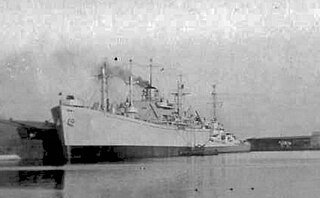See also
- USS Ulysses S. Grant
- HMS Ulysses for Royal Navy vessels
- MV Ulysses for motor vessels named Ulysses
- SS Ulysses for steamships named Ulysses
USS Ulysses may refer to:

The Victory ship was a class of cargo ship produced in large numbers by North American shipyards during World War II to replace losses caused by German submarines. They were a more modern design compared to the earlier Liberty ship, were slightly larger and had more powerful steam turbine engines giving higher speed to allow participation in high speed convoys and make them more difficult targets for German U-boats. A total of 531 Victory ships were built.

USS Abatan (AW-4) was a Pasig-class distilling ship built for the United States Navy during World War II, named after the Abatan River located in the southwestern part of Bohol Island in the Philippines.

USS Stag (AW-1) was one of four water distilling ships built for the United States Navy during World War II. The lead ship of two in her class, she was named for a ruminant mammal belonging to the family Cervidae.
Four British Royal Navy ships have been called HMS Ulysses:

USS Leonidas (AD-7) was a destroyer tender, the lone ship in her class, named for Leonidas I, and the second United States naval vessel to bear the name.

USS Sarpedon (ARB-7) was laid down as a United States Navy LST-542-class tank landing ship but was converted as one of twelve Aristaeus-class battle damage repair ships built for the Navy during World War II. Named for Sarpedon, and also she was the only US Naval vessel to bear the name.

USS Ulysses (ARB-9) was planned as a United States Navy LST-542-class tank landing ship, but was redesignated as one of twelve Aristaeus-class battle damage repair ships built for the United States Navy during World War II. Named for Ulysses, she was the second US Naval vessel to bear the name.
The SS Ulysses was the first of two steel-hulled, twin screw colliers constructed at Sparrows Point, Maryland by the Maryland Steel Company for the Panama Canal Company. The ships were to a Navy design and built under naval supervision but with major differences from the two previously constructed Navy colliers, Jason and Orion. Unlike the Navy ships and many colliers the ships had ten cargo handling king posts rather than the tall, specialized coaling booms as the ships were designed to transport coal to the Panama Canal and be unloaded by equipment there.

USS Acubens (AKS-5) was an Acubens-class general stores issue ship commissioned by the U.S. Navy for service in World War II, named after the star Acubens, the alpha star in Cancer. She was responsible for delivering and disbursing goods and equipment to locations in the war zone.

USS Oahu (ARG-5) was a Luzon-class internal combustion engine repair ship that saw service in the United States Navy during World War II. Named for the Island of Oahu, third largest island in the Hawaiian chain, it was the second US Naval vessel to bear the name.

USS Allegan (AK-225) was a Crater-class cargo ship commissioned by the U.S. Navy for service in World War II. She was responsible for delivering troops, goods and equipment to locations in the war zone.

USS Luna (AKS-7) was a Liberty ship built in the United States during World War II. She was originally named for Harriet Hosmer, a neoclassical sculptor, considered the first female professional sculptor. She was converted shortly after completion to an Acubens-class general stores issue ship and renamed Luna, the latin name for the Moon. She was responsible for delivering and disbursing goods and equipment to locations in the war zone.

USS Sturdy (PC-460/PYc-50) was a yacht converted to a patrol boat acquired by the U.S. Navy for the task of patrolling the coastal waters of the U.S. East Coast during World War II. Her primary task was to guard the coastal area against German submarines.

Built in 1918, the SS Santa Teresa was originally a passenger liner. In World War I she was requisitioned by the U.S. Navy and served under the title USS Santa Teresa. She served as a commercial vessel between the wars, first under her original name, and later as the SS Kent. During World War II she served first with the U.S. Army as the USAT Ernest Hinds, named for Major General Ernest Hinds. She was later part of the Navy as USS Kent (AP-28). She spent the final part of the war as an Army hospital ship, once more under the name USAT Ernest Hinds.

The Type C4-class ship were the largest cargo ships built by the United States Maritime Commission (MARCOM) during World War II. The design was originally developed for the American-Hawaiian Lines in 1941, but in late 1941 the plans were taken over by the MARCOM.

USS Tracer (AGR-15) was a Guardian-class radar picket ship, converted from a Liberty Ship, acquired by the US Navy in 1957. She was reconfigured as a radar picket ship and assigned to radar picket duty in the North Pacific Ocean as part of the Distant Early Warning Line.
A number of motor vessels have been named Ulysses:
A number of steamships were named Ulysses, including -

The SS Rutland Victory was a Victory ship built during World War II under the Emergency Shipbuilding program. It was built and launched by the Oregon Shipbuilding Corporation on May 9, 1944, and completed on May 29, 1944. The ship's United States Maritime Commission designation was VC2-S-AP3 and hull number 104 (1020). The ship was Oregon Shipbuilding Corporation's 20th victory ship. The Maritime Commission turned it over for Merchant navy operation to a civilian contractor, the United States Lines.